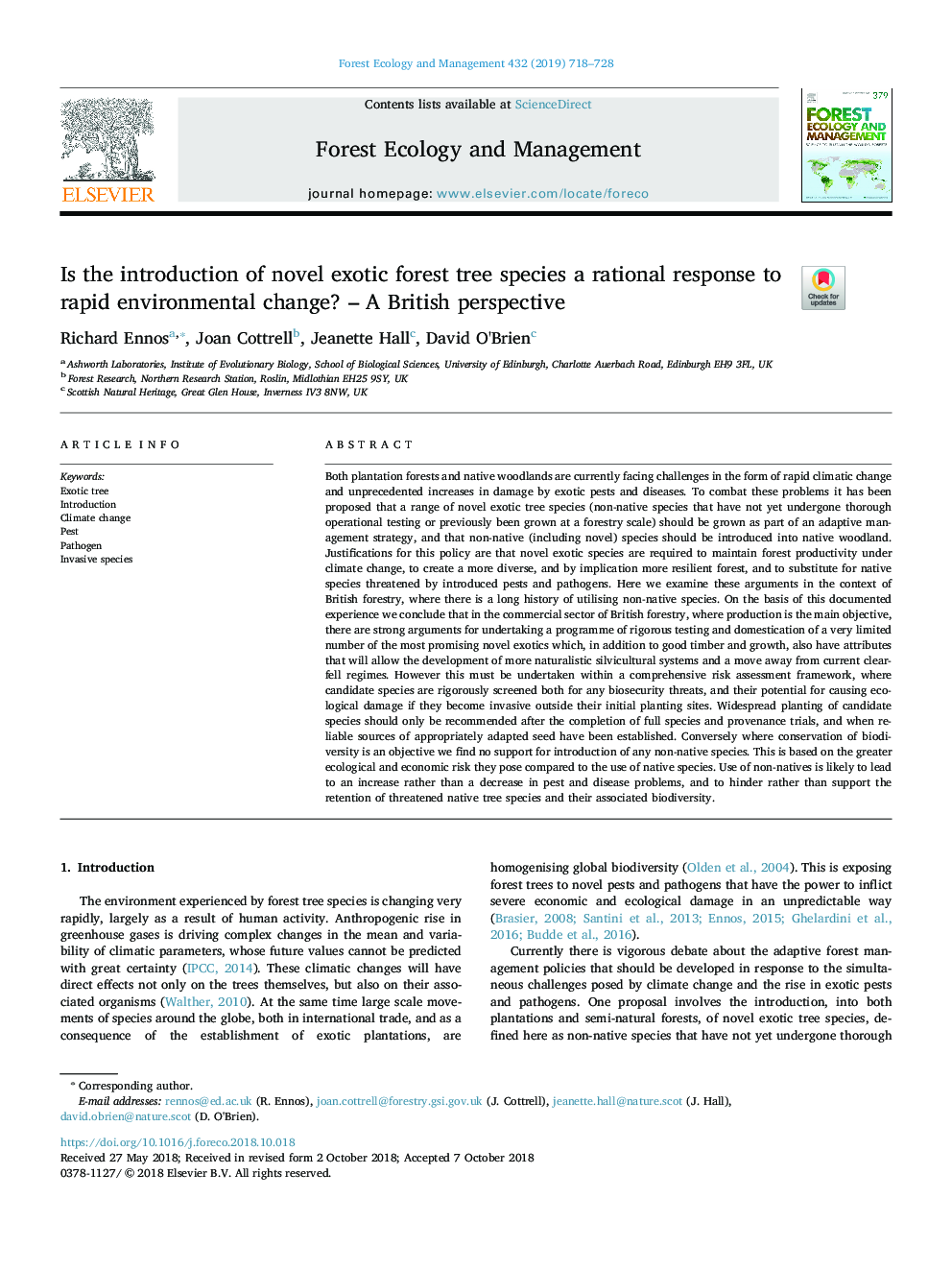| کد مقاله | کد نشریه | سال انتشار | مقاله انگلیسی | نسخه تمام متن |
|---|---|---|---|---|
| 11028336 | 1662523 | 2019 | 11 صفحه PDF | دانلود رایگان |
عنوان انگلیسی مقاله ISI
Is the introduction of novel exotic forest tree species a rational response to rapid environmental change? - A British perspective
ترجمه فارسی عنوان
معرفی گونه های جدید جنگل های عجیب و غریب یک پاسخ منطقی به تغییر سریع محیط زیست است؟ - دیدگاه بریتانیا
دانلود مقاله + سفارش ترجمه
دانلود مقاله ISI انگلیسی
رایگان برای ایرانیان
کلمات کلیدی
درخت عجیب و غریب، معرفی، تغییر آب و هوا، آفات بیماری زا، گونه های مهاجم،
ترجمه چکیده
هر دو جنگل های گیاهان دارویی و جنگل های بومی در حال حاضر با چالش هایی در معرض تغییرات اقلیمی و افزایش بی سابقه آسیب های آفات و بیماری های عجیب و غریب مواجه هستند. برای مقابله با این مشکلات پیشنهاد شده است که طیف وسیعی از گونه های جدید گونه های درختی عجیب و غریب (گونه های غیر بومی که هنوز تحت آزمایشات عملیاتی کامل قرار نگرفته اند یا قبلا در مقیاس جنگلداری رشد نکرده اند) باید به عنوان بخشی از یک استراتژی مدیریت انطباقی افزایش یافته و گونه های غیر بومی (از جمله رمان) باید به جنگل بومی وارد شوند. توجیهات این سیاست این است که گونه های جدید عجیب و غریب برای حفظ بهره وری جنگل ها از طریق تغییرات آب و هوایی، ایجاد یک جنگل متنوع تر و بطور معقول مقاوم تر و جایگزینی برای گونه های بومی تهدید شده توسط آفات و بیماری های معرفی شده مورد نیاز است. در اینجا ما این استدلال ها را در زمینه جنگلداری بریتانیا بررسی می کنیم، جایی که سابقه طولانی در استفاده از گونه های غیر بومی وجود دارد. بر اساس این تجربه مستند، نتیجه می گیریم که در بخش تجاری جنگلداری بریتانیا، که تولید اصلی هدف اصلی است، استدلال های قوی برای اجرای یک برنامه تست دقیق و اهلی سازی تعداد محدودی از امیدوار کننده ترین عناوین رمان وجود دارد علاوه بر چوب و رشد خوبی نیز دارای ویژگی هایی است که به توسعه سیستم های حیاتی بیشتر طبیعی و حرکت به دور از رژیم های سرسام آور در حال حاضر کمک می کند. با این حال این باید در چارچوب جامع ارزیابی ریسک انجام شود، جایی که گونه های نامشروع هر دو برای هر گونه تهدیدات زیست محیطی و همچنین احتمال بالقوه برای ایجاد آسیب زیست محیطی در صورت خارج شدن از سایت های کاشت اولیه تهاجم شوند. کاشت گسترده ای از گونه های کاندیدا باید پس از اتمام آزمایشات کامل گونه و پروتئین توصیه شود و زمانی که منابع قابل اعتماد بذر مناسب تنظیم شده است. در عوض در جایی که حفاظت از تنوع زیستی یک هدف است، هیچ گونه حمایت از معرفی گونه های غیر بومی پیدا نمی کنیم. این بر اساس ریسک زیست محیطی و اقتصادی بیشتر است که در مقایسه با استفاده از گونه های بومی آن را در بر می گیرد. استفاده از غیر بومی ها احتمالا منجر به افزایش، به جای کاهش مشکلات آفات و بیماری، و جلوگیری از حفظ گونه های بومی تهدید شده و تنوع زیستی مرتبط با آن می شود.
موضوعات مرتبط
علوم زیستی و بیوفناوری
علوم کشاورزی و بیولوژیک
بوم شناسی، تکامل، رفتار و سامانه شناسی
چکیده انگلیسی
Both plantation forests and native woodlands are currently facing challenges in the form of rapid climatic change and unprecedented increases in damage by exotic pests and diseases. To combat these problems it has been proposed that a range of novel exotic tree species (non-native species that have not yet undergone thorough operational testing or previously been grown at a forestry scale) should be grown as part of an adaptive management strategy, and that non-native (including novel) species should be introduced into native woodland. Justifications for this policy are that novel exotic species are required to maintain forest productivity under climate change, to create a more diverse, and by implication more resilient forest, and to substitute for native species threatened by introduced pests and pathogens. Here we examine these arguments in the context of British forestry, where there is a long history of utilising non-native species. On the basis of this documented experience we conclude that in the commercial sector of British forestry, where production is the main objective, there are strong arguments for undertaking a programme of rigorous testing and domestication of a very limited number of the most promising novel exotics which, in addition to good timber and growth, also have attributes that will allow the development of more naturalistic silvicultural systems and a move away from current clear-fell regimes. However this must be undertaken within a comprehensive risk assessment framework, where candidate species are rigorously screened both for any biosecurity threats, and their potential for causing ecological damage if they become invasive outside their initial planting sites. Widespread planting of candidate species should only be recommended after the completion of full species and provenance trials, and when reliable sources of appropriately adapted seed have been established. Conversely where conservation of biodiversity is an objective we find no support for introduction of any non-native species. This is based on the greater ecological and economic risk they pose compared to the use of native species. Use of non-natives is likely to lead to an increase rather than a decrease in pest and disease problems, and to hinder rather than support the retention of threatened native tree species and their associated biodiversity.
ناشر
Database: Elsevier - ScienceDirect (ساینس دایرکت)
Journal: Forest Ecology and Management - Volume 432, 15 January 2019, Pages 718-728
Journal: Forest Ecology and Management - Volume 432, 15 January 2019, Pages 718-728
نویسندگان
Richard Ennos, Joan Cottrell, Jeanette Hall, David O'Brien,
